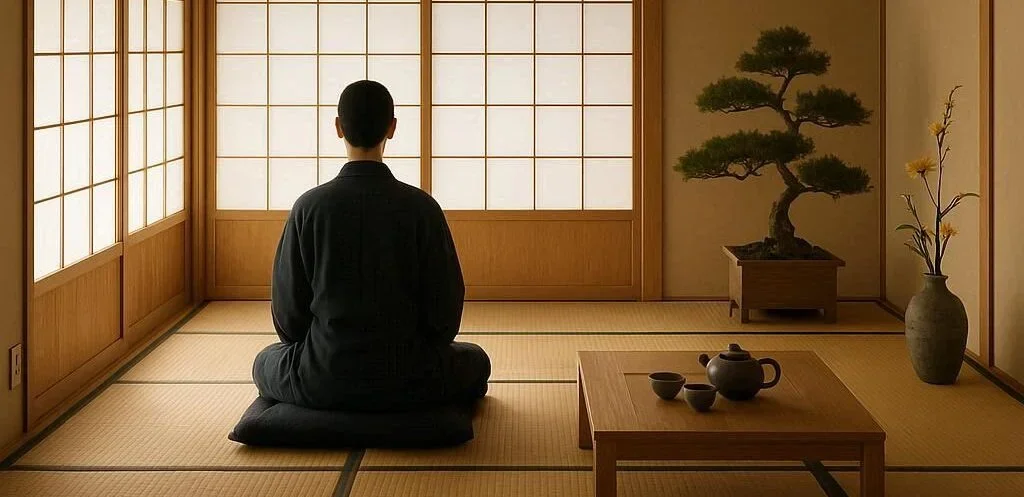512 views How Zen Philosophy Inspires Everyday Japanese Life
Zen, a school of Mahāyāna Buddhism that flourished in China and later in Japan, is more than a spiritual practice—it is a way of living. From the rhythmic tea ceremony to the disciplined workplace culture, Zen principles seep into daily life, shaping attitudes, habits, and aesthetics. In this article we explore how the notion of satori (awakening), the emphasis on sangha (community), and the practice of zazen (seated meditation) translate into tangible actions that Japanese people use to cope with modern stresses, enhance mindfulness, and create harmony in a fast‑paced world.
1. Zen as a Counterbalance to Technology
Japan is a nation of tech giants, high‑speed trains, and digital billboards, yet many Japanese still prioritize mushō—the act of letting go. This contrast is intentional: Zen teaches that constant information flow can fragment attention and breed anxiety. Instead of scrolling endlessly, people adopt mushō by setting “digital detachment” zones—time slots where screens are banned and simple activities like reading, walking, or listening to traditional instruments take precedence.
Practical Steps
- Digital Sabbath: Allocate 2–3 hours before bedtime where no electronic devices are used.
- Mindful notifications: Turn off non‑essential alerts; leave only those that address immediate needs.
- Screen‑free meals: Eat and talk without phones, reinforcing face‑to‑face interactions.
These habits echo the Zen focus on presence, making daily life more intentional.
2. The Tea Ceremony (Chadō) – An Everyday Ritual
The Japanese tea ceremony chadō (the way of tea) is an embodiment of Zen aesthetics: minimalism, impermanence, and mindful execution. While it is often presented as a cultural spectacle, the same principles are used in everyday practices.
- Simplicity in space: Declutter kitchens and desks to create an environment conducive to concentration.
- Seasonal awareness: Incorporate seasonal fruits and herbs into breakfasts, aligning diet with nature’s rhythms.
- Gratitude moments: Begin the day by pausing to appreciate sunlight, water, or breath—mirrors of the tea ceremony’s appreciation for each element.
By transferring the ritual’s mindfulness to routine tasks, Japanese households maintain a flexible yet disciplined rhythm.
3. Working Ethic – Kaizen Meets Zen
Japan’s corporate culture is famous for kaizen, the continuous improvement philosophy. Zen’s silent presence complements kaizen by encouraging calm focus during work. Employees often start the day with a ten‑minute zazen session to music or nature sounds, attuning the mind and reducing reactive stress.
Key Actions
- Morning reflection: 5–10 minutes of seated breathing, followed by a daily intention list.
- Mindful meetings: Start with a one‑sentence statement of purpose, ensuring each conversation remains purposeful.
- Breathing breaks: During lunch or project deadlines, pause for a “breathing ritual”—inhale for four seconds, hold for four, exhale for four—to reset focus.
Such practices help workers navigate deadlines without sacrificing mental clarity, blending productivity with serenity.
4. The Architectural Influence
Japanese architecture features shōji (sliding screens), tatami flooring, and tsukimi (moon‑viewing) gardens—all aspects derived from Zen perspective on space and emptiness. The design principle of ma (negative space) witnesses its application in everyday living:
- Home layout: Use open spaces for meditation, ensuring a clear mental path.
- Minimal clutter: Furniture is chosen for functional value; personal items are kept in hidden compartments, mirroring the Zen principle of “realized restraint.”
- Natural light: Windows are positioned to invite morning light, reinforcing the belief that light nurtures mindfulness.
When daily life adheres to ma, individuals experience less cognitive overload, promoting a calmer daily flow.
5. Zen in Personal Health – Yogic Breathing and Sleep
Modern Japan grapples with sleep deprivation, leading to a cultural phenomenon known as hikikomori (social withdrawal). Zen offers practical solutions:
- Noting breath (Kōhō): A technique where individuals silently observe their breath, aligning with the Buddha’s suggestion to “observe the mind, observe the body.” A simple 5‑minute practice before bed can induce a serene state.
- Japanese Suji (Japanese fonts): Reading a few calming verses or poetry slows the heart rate.
- Wed‑night routine: Incorporate light stretching, a warm cup of matcha (which contains L-theanine), and a silent walk.
These activities collectively reduce cortisol levels and improve REM sleep, allowing the mind to declutter.
6. Social Interactions – “Giri” and “Nakama”
The Zen concept of compassion influences Japanese terms giri (duty, obligation) and naka (companionship). In practice:
- Daily gratitude notes: Write a short thank‑you to a colleague or neighbor, reinforcing compassion.
- Mirroring calm: When a friend faces conflict, rather than reacting instantly, some listen first—a technique derived from the kōan of “silently listening to the bird.”
- Community “buddhist” gatherings: Neighborhood groups meet for tea or quiet reflection, strengthening naka—support networks rooted in empathy.
These interactions help maintain social harmony while avoiding clashes that could arise from disagreeing loudly.
7. Food Culture – Mindful Eating
Mindful eating is central to Zen. Traditional Japanese meal practices—washoku—follow a seasonal routine of 7–8 small dishes, each representing natural resources. This spreads attention across flavors, textures, and colors, encouraging soma (body) awareness.
Practical guidelines:
- Color-balance plate: Use a balanced mix of greens, reds, and yellows to invigorate retrieval signals.
- Chew three times each bite: Slows down intake, preventing overeating, and garners focus.
- Vivāna of “stillness”: Keep a small bowl of water to sip between bites, regulating stimulation.
Staying mindful around food encourages digestion and a more grounded sense of satisfaction.
8. Tradition meets Innovation – Zen‑Inspired Design
Electric appliances, smart homes, and AI robotics thrive in Japan. Yet, designers often infuse Zen values into products.
- Compact design: Apple, Sony, and Nintendo popularize minimalist electronics, resonating with kanso (simplicity).
- Quiet environments: Smart thermostats tune ambient noise levels, enabling people to hear their own breathing, fostering a quiet presence.
- Natural aesthetics: Home decor often uses natural wood tones and bamboo, reinforcing shizen (nature). These principles demystify technology, making it a servant of tranquility.
9. The Path to Everyday Enlightenment
Zen is not a one‑time awakening but a cumulative practice. For many Japanese who crave balance, it manifests as:
- Morning meditation (3–5 minutes) to reset.
- Daily “thank‑you” rituals (a note or a word).
- Routine “adherence to ni‑shō” (attending one group activity a week).
- Mindful reflection after the day’s events.
- Community “kanso”: Giving away unused items stimulates generosity.
By chaining simple, mindful actions, Japan exemplifies the Zen claim: Awareness is the path to liberation.
10. Takeaway – Applying Zen Beyond Japan
While Zen has roots deep in Japanese culture, its principles are universal. Anyone can start with:
- Setting aside 3 minutes a day for silent awareness.
- Tasting food slowly, noting flavors.
- Choosing minimalism in one area of life.
- Practicing gratitude daily.
If you adopt these small practices, you’ll notice increased calm, sharper focus, and a stronger connection to rhythm. In a hyper‑connected era, Zen offers a simple, sustainable counter‑culture that preserves the human spirit.
In essence, Zen philosophy is no longer a distant, abstract belief. It is embedded in everyday actions—from the way we commute, cook, and work, to how we greet strangers and sleep. It teaches us that true productivity arises not from frantic action, but from mindful presence and intentional simplicity.
By weaving Zen into everyday life, Japanese society demonstrates how spiritual wisdom can be a source of strength, resilience, and community cohesion in the 21st century.






